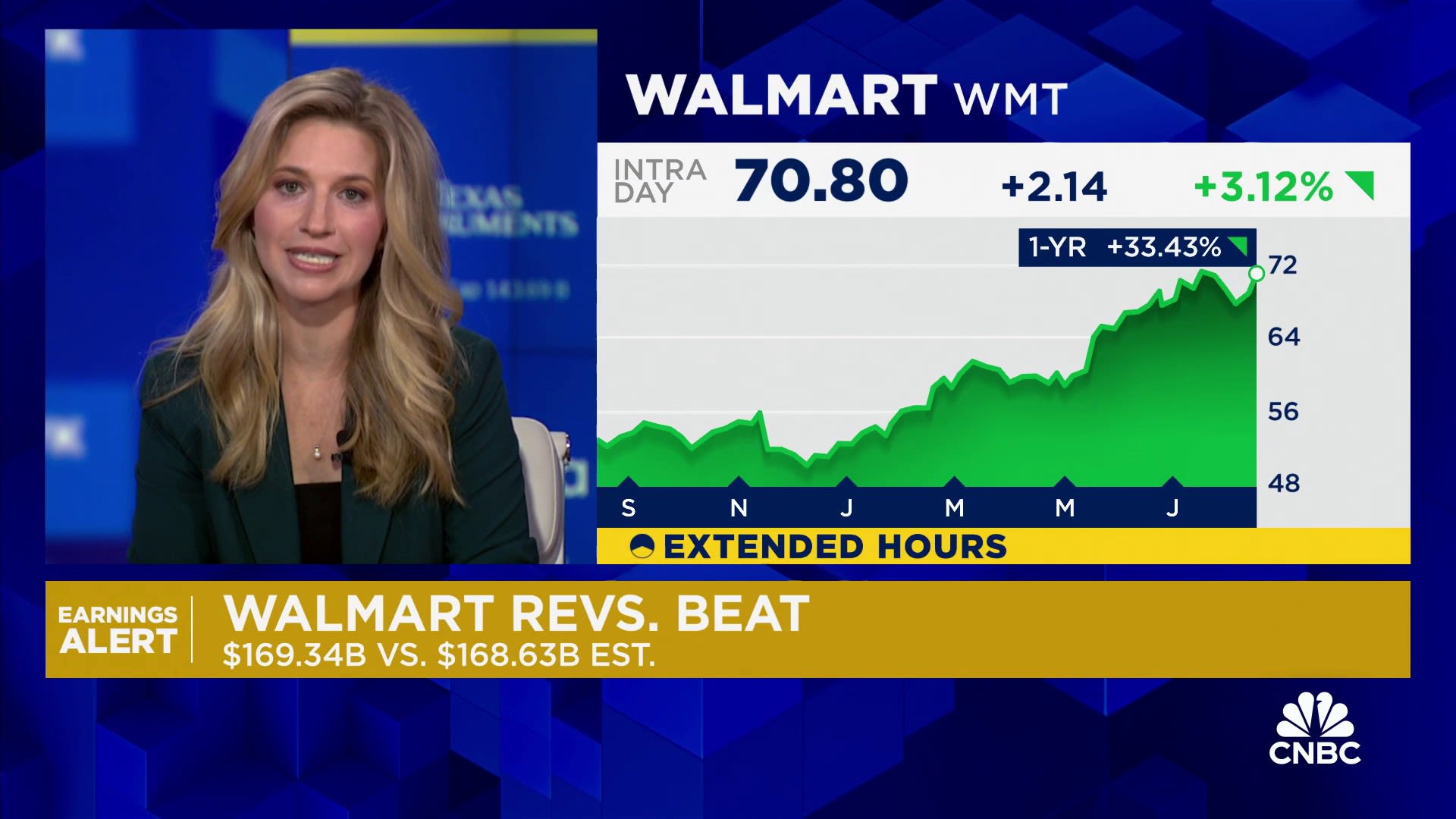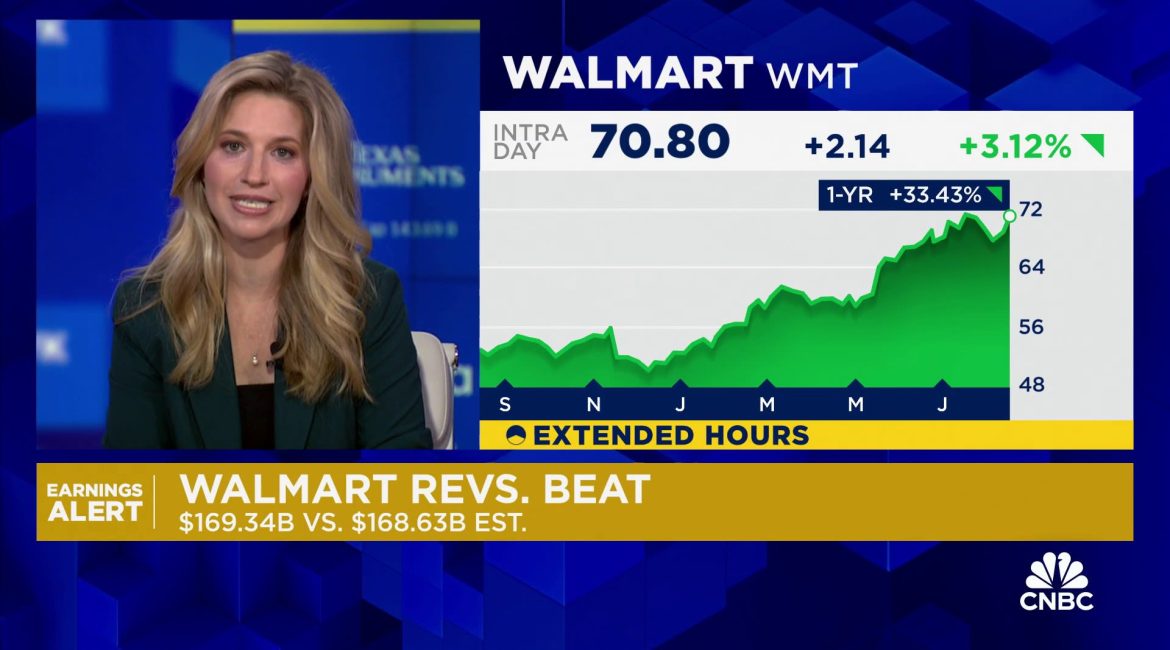
Walmart raised its forecast for the year on Thursday, as quarterly revenue grew nearly 5%, the company’s stores and website drew more visits, and sales outside the grocery department improved.
The discounter beat Wall Street’s expectations for sales and profits, and its shares climbed 6% in morning trading.
Walmart said it now expects sales to rise by 3.75% to 4.75% for the full year, and adjusted earnings to come in between $2.35 and $2.43 per share. It previously said it expected to be on the high end or slightly above its initial full-year guidance, which called for net sales growth of 3% to 4% and adjusted earnings per share of between $2.23 and $2.37.
While Walmart raised its outlook, its projected second half of the year may not be as strong as Wall Street anticipated. The retailer expects adjusted earnings of 51 to 52 cents per share in the third quarter, below analysts’ expectations of 54 cents. Analysts also expected adjusted earnings of $2.43 per share for the year — the highest point of Walmart’s guidance.
In an interview with CNBC, Chief Financial Officer John David Rainey said the company’s brighter outlook reflects strength in the first half of the year. He said Walmart decided against raising expectations for the back half of the year, especially since the 2024 election, unrest in the Middle East and other dynamics may influence consumer sentiment.
“In this environment, it’s responsible or prudent to be a little bit guarded with the outlook, but we’re not projecting a recession,” he said.
He said Walmart has not noticed a shift in consumer behavior. He said every month of the quarter was “relatively consistent” and the back-to-school season “is off to a pretty good start.”
“We see, among our members and customers, that they remain choiceful, discerning, value-seeking, focusing on things like essentials rather than discretionary items, but importantly, we don’t see any additional fraying of consumer health,” Rainey said.
Walmart saw another promising indicator: Sales of general merchandise, such as lawn and garden supplies, were positive for the first time in 11 quarters. He said those sales were up only slightly, but were an “encouraging sign for us.”
Here’s what the discounter reported for the fiscal second quarter compared with what Wall Street expected, according to a survey of analysts by LSEG:
- Earnings per share: 67 cents adjusted vs. 65 cents expected
- Revenue: $169.34 billion vs. $168.63 billion
Walmart’s net income dropped to $4.5 billion, or 56 cents per share, in the three-month period that ended July 31, compared with $7.89 billion, or 97 cents per share, in the year-ago period.
Revenue rose from $161.63 billion in the year-ago quarter.
Comparable sales for Walmart U.S. rose 4.2% in the second quarter, excluding fuel, compared with the year-ago period, which topped analysts’ expectations. The industry metric includes sales from stores and clubs open for at least a year.
At Sam’s Club, comparable sales rose 5.2%, excluding fuel, in line with analysts’ expectations.
E-commerce sales jumped 21% globally and 22% in the U.S.
Walmart’s customers in the U.S. visited the company’s stores and website more and spent slightly more during the quarter than they did in the year-ago period. Transactions rose 3.6% and average ticket was up 0.6% compared with the year-ago quarter.
Walmart provided the latest window into the health of American households and the outlook for the broader economy as investors and economists seek clarity.
As the nation’s largest retailer, Walmart is uniquely positioned to offer insights into where the consumer is spending and scrimping. The company’s reputation for value has boosted sales over the past two years, as inflation drove more higher-income shoppers to its stores and website.
Inflation has moderated and returned to historic levels, according to July data from the U.S. Department of Labor. The consumer price index, which measures prices of a broad mix of goods and services, rose 2.9% last month compared with a year earlier. That is the lowest level since March of 2021.
On the campaign trail, many politicians — including presidential candidates Vice President Kamala Harris and former President Donald Trump — have spoken about how they will take on the higher prices of everyday items, including groceries. Harris, in particular, has blamed companies for “price gouging.”
Walmart, for its part, said it is pushing vendors to reduce prices. Rainey said that’s long been a focus for the company.
He told CNBC that inflation was flat for Walmart year over year, so its sales growth was driven by selling more units rather than higher prices. He said it had 7,200 “rollbacks,” or short-term deals on items, in the quarter, including a 35% increase in the number of rollbacks on food.
Yet prices are hovering much higher than pre-pandemic, frustrating and stretching consumers. A jobs report from the Labor Department early this month also raised concerns and prompted a sharp stock market sell-off, as jobs growth slowed and the unemployment rate rose more than expected.
Some companies’ earnings reports have added to worries about the economy. Home Depot on Tuesday beat quarterly expectations for earnings and revenue, but warned of slow sales in the back half of the year and consumer caution, even among its more middle- and upper-income customer base.
Along with attracting inflation-weary shoppers, Walmart has made its own moves to drive growth. It has looked outside of traditional retail channels, as it has sought to add more sellers to its third-party marketplace, sell more advertisements and attract more members to its subscription service, Walmart+. It also launched a new grocery brand, Bettergoods, with most items under $5 — including meal solutions like frozen pizzas and chicken wings.
Rainey said Walmart is likely benefiting as customers look for cheaper alternatives to fast food. He referred to inflation data, which came out this week and showed that the gap in price between food at home and food away from home continues to grow.
“It stands to reason that customers are shifting to prepare more meals at home versus versus eating out,” he said.
Shares of Walmart closed Wednesday at $68.66. So far this year, the company’s stock is up nearly 31%, outpacing the approximately 14% gains of the S&P 500.

